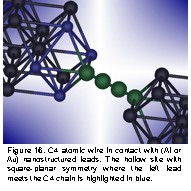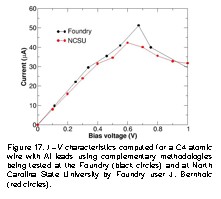Electronic transport of molecular nanostructures at finite bias voltage
Foundry Users: Wenchang Lu, Jerzy Bernholc, North Carolina State University
While several atomistic methods for theoretical treatment of systems at finite bias voltage have already been developed , questions remain concerning the reliability of these techniques and their ranges of applicability. At this stage, few successful quantitative comparisons between two substantially different theoretical methods have been made. The Theory group at the Foundry has been testing and developing a new scattering-state approach , which will be compared for select systems with a multigrid-based technique that uses Green's functions and self-energies developed by Foundry user Jerzy Bernholc at North Carolina State University . These standards will be used for future comparisons with experiment, for development of new techniques, and for theoretical improvements, such as a better treatment of electron correlation.
In conjunction with Foundry user Prof. Jerzy Bernholc, we benchmarked a simple test system, a linear 4-atom carbon chain connected by Al or Au leads. This system was chosen because of its strongly nonlinear transport properties: previous calculations predicted negative differential resistance below 1 V . Several calculations on carbon atomic chains of different lengths between nanostructured Al and Au leads were performed by both groups and compared with previous work for Al leads. We were able to reproduce and explain negative differential resistance for carbon wires of various lengths in Al and Au nanojunctions, with the onset bias depending on lead chemistry and the number of atoms in the carbon wire . The different features witnessed in the I-V characteristics for chains with Au leads provide evidence for the extreme sensitivity of single-molecules resistance to lead chemistry and geometry. The agreement between the two codes is very good, and we are in the process of extending our comparison to other systems. Recent experiments report that a carbon chain bridging single-walled carbon nanotubes exhibits negative differential resistance, possibly due to a similar effect . We are presently investigating carbon nanotube junctions covalently-bridged by carbon nanowires to confirm this.
Publication arising from this work: J.B. Neaton, K.H. Khoo, C.D. Spataru, and S.G. Louie, "Electron transport and optical properties of carbon nanostructures from first principles," Computer Physics Communications 169 (1-3), p.1, (2005).




